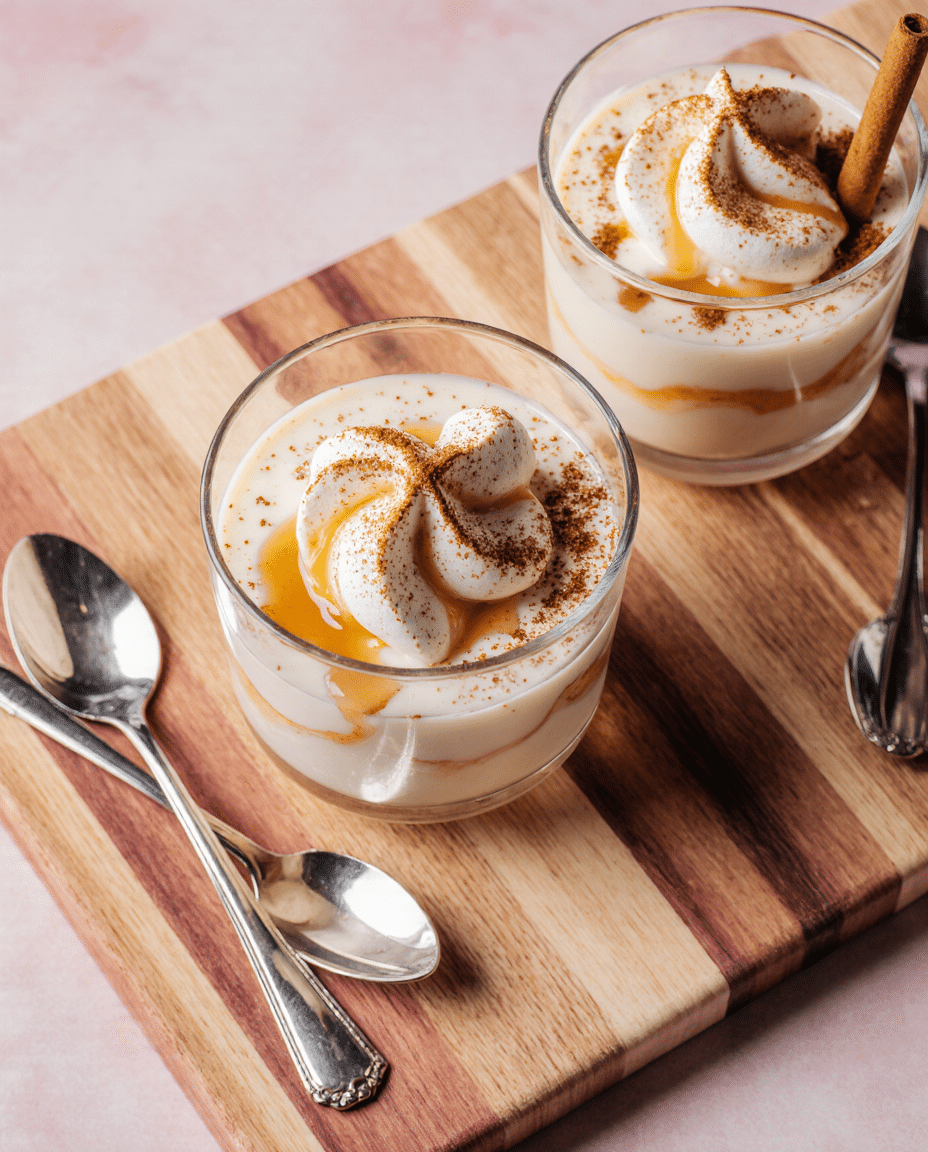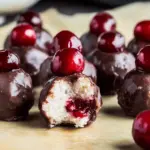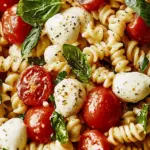Chilean Floating Islands, known locally as Leche Nevada, are a delicate and timeless dessert that perfectly captures the essence of comfort food. Imagine light, airy meringue clouds gently poached and then nestled atop a rich, velvety vanilla custard. Each spoonful offers a beautiful contrast of textures—pillowy meringue melting into creamy custard—making it a treat that feels indulgent yet refined.
This dessert is a beloved part of Chilean culinary heritage and is often enjoyed during family gatherings and special occasions. Its elegance lies in its simplicity: eggs, milk, sugar, and vanilla transformed into a dessert that looks as stunning as it tastes. Whether served as a centerpiece for dinner parties or as a sweet reward at the end of a meal, Leche Nevada promises to impress and comfort in equal measure.
Full Recipe:
Ingredients:
-
4 large eggs, separated
-
1 cup (200 g) sugar, divided
-
4 cups (1 liter) whole milk
-
1 teaspoon vanilla extract
-
1 tablespoon cornstarch
-
Pinch of salt
Directions:
-
Separate the egg whites and yolks into two different bowls.
-
In a large mixing bowl, whisk the egg whites with a pinch of salt until soft peaks form. Gradually add half of the sugar (½ cup) and continue whisking until stiff peaks form, creating a glossy meringue.
-
Heat the milk in a large saucepan over medium-low heat until just simmering. Using two spoons, scoop the meringue into oval-shaped quenelles and gently float them in the hot milk. Poach each side for about 1 minute, carefully turning them. Remove with a slotted spoon and place on a tray. Continue until all meringue is cooked.
-
In another bowl, whisk the egg yolks with the remaining sugar and cornstarch until pale and thick. Slowly pour in about 1 cup of the hot milk while whisking constantly to temper the eggs.
-
Pour the yolk mixture back into the saucepan with the remaining milk, stirring over low heat until it thickens into a custard. Do not let it boil. Remove from heat and stir in the vanilla extract.
-
Pour the custard into serving bowls or glasses. Gently place the poached meringue “islands” on top of the custard.
-
Chill for at least 1 hour before serving. Optional: garnish with a drizzle of caramel or a sprinkle of cinnamon.
Prep Time: 15 minutes | Cooking Time: 20 minutes | Total Time: 35 minutes
Kcal: 230 kcal | Servings: 6 servings
Chilean Floating Islands (Leche Nevada): A Taste of Clouds Over Custard
When it comes to desserts that combine elegance with simplicity, few can rival the ethereal beauty of Chilean Floating Islands, or Leche Nevada. This traditional dish is a celebration of lightness and creaminess, a culinary representation of clouds drifting gently across a sweet, custardy sky. With its soft, airy meringue islands floating serenely atop a pool of rich vanilla custard, Leche Nevada is more than a dessert—it’s a cultural experience, a family tradition, and a sweet reminder of the ingenuity of simple ingredients transformed through love and technique.
In Chile, Leche Nevada has become a dessert that symbolizes home, heritage, and hospitality. Whether served at Sunday family lunches, festive gatherings, or simply as a treat to brighten the week, this dish carries an emotional connection that goes beyond its taste. It embodies both nostalgia and comfort, appealing to those who grew up with it and enchanting new generations with its delicate textures.
In this article, we’ll dive deep into the origins, flavors, preparation tips, variations, serving ideas, and cultural significance of Leche Nevada. By the end, you’ll understand why this dessert has stood the test of time and why it deserves a special place at your table.
The History of Leche Nevada
The story of Leche Nevada traces back to both European and Latin American culinary traditions. Its roots lie in the French dessert known as Île Flottante (Floating Island), which consists of poached meringues served over crème anglaise. French immigrants and European culinary influence in South America during the colonial and post-colonial periods contributed to the adaptation of this dish. Over time, Chilean cooks took the concept and made it their own, creating what is now beloved as Leche Nevada.
While the French version often includes caramel sauce or almond garnishes, the Chilean version emphasizes simplicity: clouds of meringue cooked directly in milk, resting on a custard base infused with vanilla. This unique method gives Leche Nevada a distinctive texture and flavor profile that sets it apart. The name itself, “Nevada,” means “snow-covered” in Spanish, reflecting the snowy, fluffy appearance of the meringue islands.
In Chilean households, Leche Nevada is not just a dessert for special occasions; it is a sweet comfort food that reminds many of their childhood. Grandmothers often prepared it as a way of transforming humble ingredients—eggs, milk, sugar—into something extraordinary. Over generations, it became deeply tied to Chilean culinary identity.
The Magic of Simplicity: Ingredients in Focus
One of the most fascinating aspects of Leche Nevada is how it relies on just a handful of everyday ingredients to produce a dessert that feels luxurious and refined. Let’s break down the key elements:
Eggs
The stars of the recipe are undoubtedly the eggs. The whites are beaten into glossy peaks, becoming the “islands” that float atop the custard. Meanwhile, the yolks are used to enrich the base, lending it its golden hue and creamy consistency. Fresh, high-quality eggs make all the difference in both flavor and texture.
Milk
Whole milk is traditionally used to provide the custard with its velvety body. In Chile, many households use fresh farm milk, which gives a depth of flavor and richness. The milk also serves as the poaching liquid for the meringue, infusing it with subtle creaminess.
Sugar
Sugar sweetens both the meringue and the custard. Its dual role balances the dessert, ensuring that the egg whites are stabilized during beating and the custard achieves a smooth, caramel-like sweetness.
Vanilla
Vanilla extract or vanilla bean adds warmth and aroma to the custard. While some modern cooks substitute with artificial flavoring, the true magic comes from real vanilla, which elevates the dish with its floral and earthy notes.
Cornstarch
A small amount of cornstarch thickens the custard to just the right consistency—not too runny, not too stiff. This ingredient ensures that the custard holds the meringue gracefully, allowing it to “float” without sinking.
The Flavor and Texture Experience
Describing Leche Nevada is like trying to put a cloud into words. Each spoonful brings together contrasting yet harmonious sensations:
-
The Meringue: Light, airy, and slightly chewy on the outside with a marshmallow-like interior. It almost dissolves in the mouth, leaving behind a faint sweetness.
-
The Custard: Creamy, smooth, and rich with a comforting vanilla flavor. It provides the grounding element that complements the ethereal meringue.
-
The Combination: When eaten together, the contrast of textures is pure magic—the cloudlike meringue yielding into the custard’s silky embrace.
This duality of lightness and richness makes the dessert so appealing. It doesn’t overwhelm the palate, yet it satisfies a sweet craving in the most delicate way.
Culinary Techniques That Make a Difference
Preparing Leche Nevada is not difficult, but it does require some technique to achieve the perfect result. These tips can help ensure success:
-
Whipping Egg Whites: Beat egg whites in a clean, dry bowl free of grease or residue. Adding sugar gradually ensures stability and glossy peaks.
-
Poaching the Meringue: Keep the milk at a gentle simmer—too hot, and the meringue may collapse; too cold, and it won’t cook properly.
-
Tempering Egg Yolks: Slowly adding hot milk to the yolks prevents them from scrambling. This is a crucial step to create a smooth custard.
-
Custard Thickness: Stir constantly over low heat until the custard lightly coats the back of a spoon. Overcooking will cause it to curdle.
-
Cooling Time: Allow the dessert to chill so the flavors meld and the textures set. Serving it too warm may cause the meringue to lose its shape.
These small details transform a simple dish into a masterpiece of balance and elegance.
Variations and Creative Twists
While traditional Leche Nevada holds a special place in Chilean hearts, modern cooks have experimented with creative adaptations:
-
Caramel Drizzle: Adding a thin stream of caramel over the meringue provides a bittersweet contrast.
-
Cinnamon Dusting: A sprinkle of ground cinnamon enhances the custard’s warmth.
-
Chocolate Custard: Replacing part of the milk with cocoa creates a more decadent base.
-
Fruit Garnish: Fresh berries or passionfruit add acidity and color.
-
Nut Crunch: Toasted almonds or pistachios introduce texture.
These twists keep the dessert relevant for contemporary palates while respecting its roots.
Serving Suggestions
Leche Nevada can be presented in various ways depending on the occasion:
-
Individual Cups: Perfect for dinner parties, allowing for elegant presentation.
-
Family-Style Dish: Traditional households often serve it in a large bowl for sharing.
-
Decorative Glasses: Layered in clear glasses, the contrast of white meringue and golden custard becomes visually stunning.
-
Festive Touch: Garnish with edible flowers or a drizzle of dulce de leche for special celebrations.
Regardless of presentation, the dessert’s beauty shines through its natural simplicity.
Nutritional Insights
Though indulgent, Leche Nevada is lighter than many cream-based desserts. A serving provides protein from eggs and calcium from milk, along with energy from sugar. It is not overly heavy, making it an excellent choice after a hearty meal. For a lighter option, reduced-fat milk and a sugar substitute may be used, though the flavor and texture may vary.
Cultural Significance in Chile
For Chileans, Leche Nevada represents more than just a sweet course—it reflects the values of family and tradition. It is often one of the first desserts children learn to eat with delight and one of the first recipes young cooks attempt under the guidance of older relatives. Its preparation is seen as an act of care and hospitality, a way to bring comfort to loved ones.
This dessert also bridges generations. Grandparents share stories of enjoying it during their youth, parents prepare it for Sunday lunches, and children carry forward the tradition by serving it at their own tables. In this way, Leche Nevada is not just a recipe but a thread connecting the past with the present.
Pairing Ideas
To elevate the experience of Leche Nevada, consider pairing it with:
-
Drinks: A strong espresso, a sweet dessert wine like late-harvest Sauvignon Blanc, or even herbal teas.
-
Sides: Light butter cookies, almond biscotti, or fresh fruit slices complement the dessert without overpowering it.
-
Occasions: From Christmas dinners to casual weeknight indulgence, Leche Nevada is versatile enough for both everyday enjoyment and special celebrations.
Storage and Make-Ahead Tips
Leche Nevada is best enjoyed fresh, but it can be stored in the refrigerator for up to two days. Keep the custard and meringue in separate containers to prevent the islands from deflating or absorbing too much moisture. Assemble just before serving for the best texture.
Conclusion
Chilean Floating Islands, or Leche Nevada, is a dessert that captures the beauty of simplicity. With just eggs, milk, sugar, and vanilla, it transforms everyday ingredients into an elegant dish that feels both comforting and luxurious. Its light meringue clouds and velvety custard remind us that food is not just about sustenance—it is about memory, tradition, and joy.
Whether you’re discovering it for the first time or revisiting a childhood classic, Leche Nevada invites you to slow down, savor, and appreciate the artistry of simple cooking. It is a dessert that transcends time and place, making it a worthy addition to any table, anywhere in the world.







Oh my goodness! a tremendous article dude. Thanks Nevertheless I’m experiencing subject with ur rss . Don’t know why Unable to subscribe to it. Is there anybody getting similar rss problem? Anybody who is aware of kindly respond. Thnkx